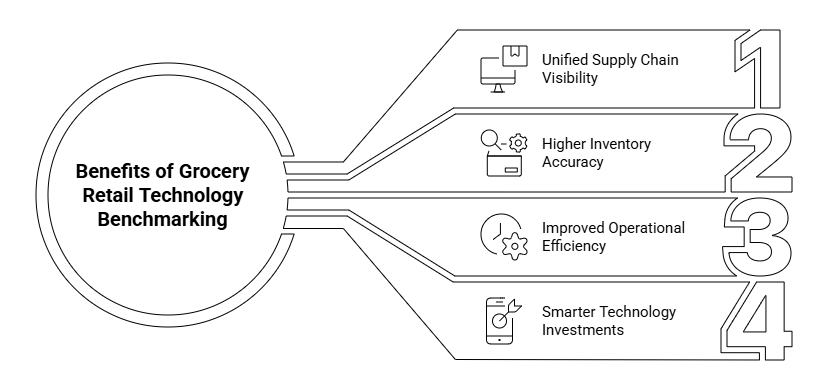The grocery retail industry is being reshaped by digital transformation. From AI-powered demand forecasting to warehouse automation and last-mile delivery optimization, technology now determines how efficiently retailers manage inventory, fulfill orders, and serve customers.
Yet, as retailers race to modernize, many face a familiar challenge of fragmented technology ecosystems. Multiple vendors, unintegrated systems, and region-specific solutions often lead to data silos, inconsistent visibility, and rising operational costs. The result: inefficiencies that directly impact product availability, delivery timelines, and customer experience.
To thrive in a competitive, low-margin market, grocery retailers must not only adopt technology but also measure and benchmark its performance. Benchmarking enables decision-makers to identify gaps in digital maturity, compare solutions across global peers, and ensure every investment enhances visibility, efficiency, and profitability across the supply chain.
Nexdigm’s Grocery Retail Technology Benchmarking Framework
The modern grocery retail supply chain runs on technology, but ensuring every tool contributes measurable value requires more than implementation. It requires comparative visibility. Nexdigm’s Grocery Retail Technology Benchmarking Framework provides this visibility by combining competitive intelligence, process analytics, and ROI benchmarking to help retailers digitize operations end-to-end.
Our approach measures how effectively technology connects procurement, warehousing, logistics, and delivery systems to enable a truly integrated digital supply chain.
Core Components of the Framework
- End-to-End Technology Mapping: Nexdigm begins by mapping the retailer’s entire digital ecosystem, covering ERP systems, warehouse management (WMS), transportation management (TMS), and point-of-sale (POS) platforms. This comprehensive audit identifies overlaps, inefficiencies, and integration gaps across the value chain.
- Performance and ROI Benchmarking: Every system is benchmarked on key operational KPIs, enabling retailers to quantify ROI and pinpoint areas of underperformance.
- Integration and Data Flow Analysis: We assess how well platforms communicate across the supply chain. Benchmarking interoperability and data synchronization ensures retailers can achieve real-time visibility from supplier to shelf.
- Automation and Analytics Capability Evaluation: Nexdigm benchmarks the adoption and impact of AI-driven demand forecasting, robotics in warehousing, and predictive analytics to measure how automation improves responsiveness and reduces manual intervention.
- Vendor and Technology Maturity Comparison: By comparing digital maturity levels of vendors and technologies across regions, Nexdigm helps retailers select solutions that combine innovation with scalability and local adaptability.
- Digital Transformation Roadmap: Benchmarking insights are consolidated into a strategic modernization plan, outlining technology priorities, adoption sequencing, and measurable KPIs to guide long-term digital investments.
Through this framework, Nexdigm helps grocery retailers transform fragmented systems into synchronized digital ecosystems, achieving operational resilience, lower costs, and faster, more reliable fulfillment cycles.
Strategic Benefits for Grocery Retail Enterprises
Digitization in grocery retail is about ensuring every system delivers measurable value across the supply chain. Nexdigm’s benchmarking insights empower retailers to align innovation with efficiency, helping them transition from operational complexity to intelligent, data-driven growth.
Key Strategic Benefits

- Unified Supply Chain Visibility: Benchmarking helps retailers identify integration gaps and build connected ecosystems across procurement, inventory, logistics, and stores, ensuring real-time visibility and proactive decision-making from supplier to customer.
- Higher Inventory Accuracy and Reduced Stockouts: Through performance benchmarking of demand forecasting tools, warehouse automation, and replenishment systems, retailers can minimize stock imbalances and improve product availability across channels.
- Improved Operational Efficiency and Throughput: Comparative insights into picking speeds, delivery timelines, and order accuracy help optimize fulfillment processes, driving faster turnaround and lower logistics costs.
- Smarter Technology Investments: Benchmarking enables decision-makers to evaluate the ROI of existing tools, eliminate redundant systems, and prioritize high-impact technologies that maximize performance and scalability.
Ultimately, Nexdigm’s Grocery Retail Technology Benchmarking Framework transforms digital complexity into measurable competitiveness, enabling grocery enterprises to deliver faster, smarter, and more sustainable supply chain performance.
To take the next step, simply visit our Request a Consultation page and share your requirements with us.
Harsh Mittal
+91-8422857704

